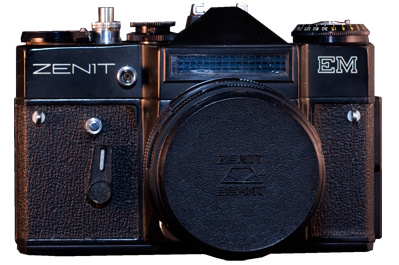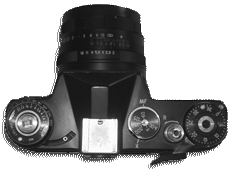
Approx. dates of manufacture: 1972 to 1984
Lens Mount: Pentax/Praktica Universal Screw mount (M42)
Approx. street value: low
If you want an good analogy of where the Soviets were at in the years between the end of World War II and the Dissolution in 1991, take a look at their cameras and their history.
This is a Zenit EM, built by the Russians just outside Moscow. The factory was Krasnogorsk Mechanical Plant, more commonly called KMZ. They had made optics and photographic equipment during the war, and afterward they turned to civilian production, turning out a variety of things from cameras to lenses to telescopes and lasers.
Their most successful 35mm camera line was the Zenit ("zenith" in english). They churned out huge numbers of them, sold them cheap, and as a result there are a ton of them around (not so much in the USA, but certainly in Europe and any country with strong trade with the USSR). The big one was the Zenit E, which was introduced in 1965 and ran until 1982, an incredible life span for a 35mm SLR. Over that period they tweaked it and released variations of it, including the B, ET, and this guy here, the EM.
It's the sort of the camera that could thrive behind the iron curtain. By western (especially Japanese) standards it was obsolete the day it was introduced in 1972: its meter was a selenium cell mounted above the lens (comparable cameras were metering through-the-lens (TTL)), and it used the M42 "universal screw mount" system. That put it in fine company with other screw-mount cameras like Miranda (soon to go out of business), Mamiya (soon to get out of the 35mm SLR market), Canon (quit using screw-mounts in the 1960s), Praktica (an East German company). It was a '57 Nash Rambler in 1972. It was a '57 Nash Rambler during the 1984 Los Angeles Olympics when it was still being made.
Two good things I like about it, however, are exactly what made it obsolete. It doesn't need batteries because it uses that old photocell; and because it's screw-mount, I happen to have some lenses that will fit it. Try that with bayonet-mount cameras.
My camera is the one pictured here, an all-black version (there were chome-body versions too) with an accessory-shoe (I've seen some that did not have that) on top of the prism. I was hoping to get a 1980 Moscow Olympics model, but for the price I paid I can't quibble.
 It's fun looking at how this thing differs from other cameras at the time. Mostly it can be figured out intuitively—the film advance lever,
the shutter post, the self-timer, the take-up, etc, are where you'd expect them on a camera like this. The shutter speed knob is a little weird
because there's an outer collar that allows synch for bulbs (MF) or electronic flash (X), and an upper shutter dial that only goes between
1/500th and 1/30th (plus B), and you have to set it against a mark on the center-post of the dial, not on the outside. And
the shutter release post has a collar with an "R" and a double-arrow, which according to the manual is a "disengage" for rewinding the film.
It's fun looking at how this thing differs from other cameras at the time. Mostly it can be figured out intuitively—the film advance lever,
the shutter post, the self-timer, the take-up, etc, are where you'd expect them on a camera like this. The shutter speed knob is a little weird
because there's an outer collar that allows synch for bulbs (MF) or electronic flash (X), and an upper shutter dial that only goes between
1/500th and 1/30th (plus B), and you have to set it against a mark on the center-post of the dial, not on the outside. And
the shutter release post has a collar with an "R" and a double-arrow, which according to the manual is a "disengage" for rewinding the film.
The other big difference is the meter, which is match-needle, but the needle window is on the top of the camera on the left side, so you have to take your eye out of the viewfinder to set the lens. Most cameras by this time had the meter needles visible inside the viewfinder.
I take it I got an "export" model, probably for England and English-speaking areas, because the camera is largely marked in English (i.e. "made in USSR" in the bottom plate). I was fortunate enough to get the manual with it (though it's falling apart) in both English and French. I also got a couple rolls of film with it—one exposed and one still in the camera (the one that was exposed yielded nothing).
Camera manual: Orphan Cameras.com


